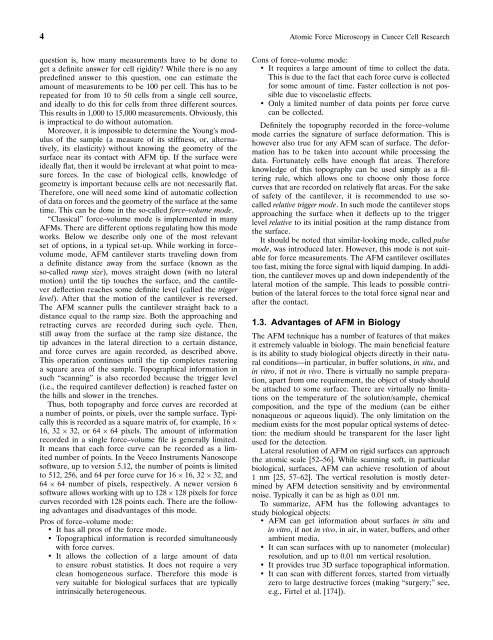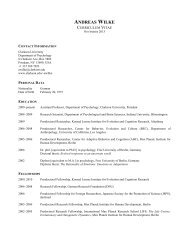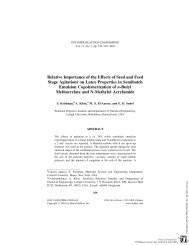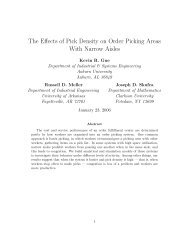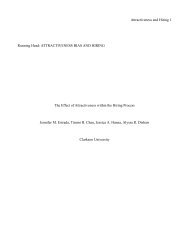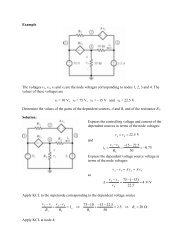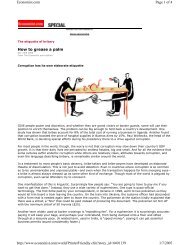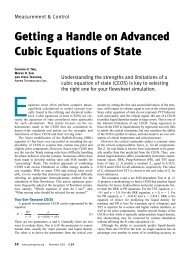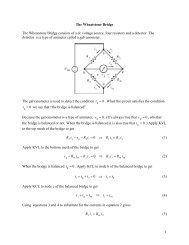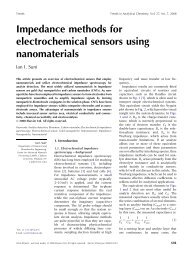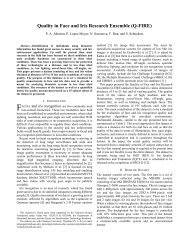Atomic Force Microscopy in Cancer Cell Research - Clarkson ...
Atomic Force Microscopy in Cancer Cell Research - Clarkson ...
Atomic Force Microscopy in Cancer Cell Research - Clarkson ...
Create successful ePaper yourself
Turn your PDF publications into a flip-book with our unique Google optimized e-Paper software.
4 <strong>Atomic</strong> <strong>Force</strong> <strong>Microscopy</strong> <strong>in</strong> <strong>Cancer</strong> <strong>Cell</strong> <strong>Research</strong><br />
question is, how many measurements have to be done to<br />
get a def<strong>in</strong>ite answer for cell rigidity? While there is no any<br />
predef<strong>in</strong>ed answer to this question, one can estimate the<br />
amount of measurements to be 100 per cell. This has to be<br />
repeated for from 10 to 50 cells from a s<strong>in</strong>gle cell source,<br />
and ideally to do this for cells from three different sources.<br />
This results <strong>in</strong> 1,000 to 15,000 measurements. Obviously, this<br />
is impractical to do without automation.<br />
Moreover, it is impossible to determ<strong>in</strong>e the Young’s modulus<br />
of the sample (a measure of its stiffness, or, alternatively,<br />
its elasticity) without know<strong>in</strong>g the geometry of the<br />
surface near its contact with AFM tip. If the surface were<br />
ideally flat, then it would be irrelevant at what po<strong>in</strong>t to measure<br />
forces. In the case of biological cells, knowledge of<br />
geometry is important because cells are not necessarily flat.<br />
Therefore, one will need some k<strong>in</strong>d of automatic collection<br />
of data on forces and the geometry of the surface at the same<br />
time. This can be done <strong>in</strong> the so-called force–volume mode.<br />
“Classical” force–volume mode is implemented <strong>in</strong> many<br />
AFMs. There are different options regulat<strong>in</strong>g how this mode<br />
works. Below we describe only one of the most relevant<br />
set of options, <strong>in</strong> a typical set-up. While work<strong>in</strong>g <strong>in</strong> force–<br />
volume mode, AFM cantilever starts travel<strong>in</strong>g down from<br />
a def<strong>in</strong>ite distance away from the surface (known as the<br />
so-called ramp size), moves straight down (with no lateral<br />
motion) until the tip touches the surface, and the cantilever<br />
deflection reaches some def<strong>in</strong>ite level (called the trigger<br />
level). After that the motion of the cantilever is reversed.<br />
The AFM scanner pulls the cantilever straight back to a<br />
distance equal to the ramp size. Both the approach<strong>in</strong>g and<br />
retract<strong>in</strong>g curves are recorded dur<strong>in</strong>g such cycle. Then,<br />
still away from the surface at the ramp size distance, the<br />
tip advances <strong>in</strong> the lateral direction to a certa<strong>in</strong> distance,<br />
and force curves are aga<strong>in</strong> recorded, as described above.<br />
This operation cont<strong>in</strong>ues until the tip completes raster<strong>in</strong>g<br />
a square area of the sample. Topographical <strong>in</strong>formation <strong>in</strong><br />
such “scann<strong>in</strong>g” is also recorded because the trigger level<br />
(i.e., the required cantilever deflection) is reached faster on<br />
the hills and slower <strong>in</strong> the trenches.<br />
Thus, both topography and force curves are recorded at<br />
a number of po<strong>in</strong>ts, or pixels, over the sample surface. Typically<br />
this is recorded as a square matrix of, for example, 16 ×<br />
16, 32 × 32,or64× 64 pixels. The amount of <strong>in</strong>formation<br />
recorded <strong>in</strong> a s<strong>in</strong>gle force–volume file is generally limited.<br />
It means that each force curve can be recorded as a limited<br />
number of po<strong>in</strong>ts. In the Veeco Instruments Nanoscope<br />
software, up to version 5.12, the number of po<strong>in</strong>ts is limited<br />
to 512, 256, and 64 per force curve for 16 × 16, 32 × 32, and<br />
64 × 64 number of pixels, respectively. A newer version 6<br />
software allows work<strong>in</strong>g with up to 128 × 128 pixels for force<br />
curves recorded with 128 po<strong>in</strong>ts each. There are the follow<strong>in</strong>g<br />
advantages and disadvantages of this mode.<br />
Pros of force–volume mode:<br />
• It has all pros of the force mode.<br />
• Topographical <strong>in</strong>formation is recorded simultaneously<br />
with force curves.<br />
• It allows the collection of a large amount of data<br />
to ensure robust statistics. It does not require a very<br />
clean homogeneous surface. Therefore this mode is<br />
very suitable for biological surfaces that are typically<br />
<strong>in</strong>tr<strong>in</strong>sically heterogeneous.<br />
Cons of force–volume mode:<br />
• It requires a large amount of time to collect the data.<br />
This is due to the fact that each force curve is collected<br />
for some amount of time. Faster collection is not possible<br />
due to viscoelastic effects.<br />
• Only a limited number of data po<strong>in</strong>ts per force curve<br />
can be collected.<br />
Def<strong>in</strong>itely the topography recorded <strong>in</strong> the force–volume<br />
mode carries the signature of surface deformation. This is<br />
however also true for any AFM scan of surface. The deformation<br />
has to be taken <strong>in</strong>to account while process<strong>in</strong>g the<br />
data. Fortunately cells have enough flat areas. Therefore<br />
knowledge of this topography can be used simply as a filter<strong>in</strong>g<br />
rule, which allows one to choose only those force<br />
curves that are recorded on relatively flat areas. For the sake<br />
of safety of the cantilever, it is recommended to use socalled<br />
relative trigger mode. In such mode the cantilever stops<br />
approach<strong>in</strong>g the surface when it deflects up to the trigger<br />
level relative to its <strong>in</strong>itial position at the ramp distance from<br />
the surface.<br />
It should be noted that similar-look<strong>in</strong>g mode, called pulse<br />
mode, was <strong>in</strong>troduced later. However, this mode is not suitable<br />
for force measurements. The AFM cantilever oscillates<br />
too fast, mix<strong>in</strong>g the force signal with liquid damp<strong>in</strong>g. In addition,<br />
the cantilever moves up and down <strong>in</strong>dependently of the<br />
lateral motion of the sample. This leads to possible contribution<br />
of the lateral forces to the total force signal near and<br />
after the contact.<br />
1.3. Advantages of AFM <strong>in</strong> Biology<br />
The AFM technique has a number of features of that makes<br />
it extremely valuable <strong>in</strong> biology. The ma<strong>in</strong> beneficial feature<br />
is its ability to study biological objects directly <strong>in</strong> their natural<br />
conditions—<strong>in</strong> particular, <strong>in</strong> buffer solutions, <strong>in</strong> situ, and<br />
<strong>in</strong> vitro, ifnot<strong>in</strong> vivo. There is virtually no sample preparation,<br />
apart from one requirement, the object of study should<br />
be attached to some surface. There are virtually no limitations<br />
on the temperature of the solution/sample, chemical<br />
composition, and the type of the medium (can be either<br />
nonaqueous or aqueous liquid). The only limitation on the<br />
medium exists for the most popular optical systems of detection:the<br />
medium should be transparent for the laser light<br />
used for the detection.<br />
Lateral resolution of AFM on rigid surfaces can approach<br />
the atomic scale [52–56]. While scann<strong>in</strong>g soft, <strong>in</strong> particular<br />
biological, surfaces, AFM can achieve resolution of about<br />
1 nm [25, 57–62]. The vertical resolution is mostly determ<strong>in</strong>ed<br />
by AFM detection sensitivity and by environmental<br />
noise. Typically it can be as high as 0.01 nm.<br />
To summarize, AFM has the follow<strong>in</strong>g advantages to<br />
study biological objects:<br />
• AFM can get <strong>in</strong>formation about surfaces <strong>in</strong> situ and<br />
<strong>in</strong> vitro, if not <strong>in</strong> vivo, <strong>in</strong> air, <strong>in</strong> water, buffers, and other<br />
ambient media.<br />
• It can scan surfaces with up to nanometer (molecular)<br />
resolution, and up to 0.01 nm vertical resolution.<br />
• It provides true 3D surface topographical <strong>in</strong>formation.<br />
• It can scan with different forces, started from virtually<br />
zero to large destructive forces (mak<strong>in</strong>g “surgery;” see,<br />
e.g., Firtel et al. [174]).


